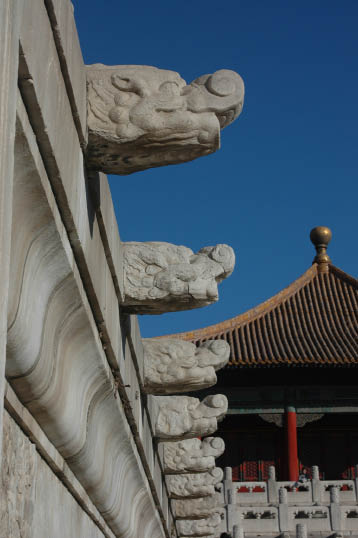| Animal Figures and Ancient Buildings
By staff reporter WU BING
Baxia, the mythical seventh son of the dragon, as drainage outlets in the Forbidden City. Zhao Yayuan
ANIMAL images are common on traditional-style buildings in China, and they have connotations and symbolic functions dependent on the particular species and its structural location.
Gate Guardians
Carved stone lions are a common sight at the gates of old buildings. These beasts were first brought into China by Zhang Qian, an imperial envoy from the Han court who made several trips to Central and Western Asia in the second century BC. Powerful and imposing, the big cat immediately won Chinese hearts, and enjoyed a status equal to that of the tiger, king of the forest. After Buddhism became the dominant religion in China, the lion’s divine mystique reached new heights. The reason lies in the story of Sakyamuni’s birth, when he is said to have roared like a lion, gesturing upward with one hand and down with the other, declaring: “In the heaven or on earth, I am the only lord.”
Before the seventh century stone lions exclusively “guarded” royal mausoleums: all were of awe-inspiring size and ferocity. Later these stone lions were allowed to take up watch by civilian doorways. During the Tang Dynasty (618-907) city-dwellers lived in walled neighborhoods, usually guarded at their entrance by a gate-tower. The columns supporting the structure were stabilized with a pair of rocks to resist gales and earthquakes. Gradually people began carving these rocks into auspicious animals such as lions, Xiezhi and Pixiu (both mythical creatures) for decorative purposes. The practice became widespread, and eventually became standard.
Of these “door-keepers,” lions far outnumber other animals. They could be seen at imperial palaces, government offices, and mansions of the rich and privileged too, a display of the power and dignity of the occupants. A pair of such beasts guards the bridge over the Jinshui (Golden Water) River that leads to the entrance of the Forbidden City in Beijing, intimidating those who pass with their bulging, glowering eyes, and their open jaws showing rows of sharp teeth.
| 
